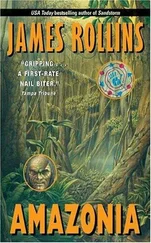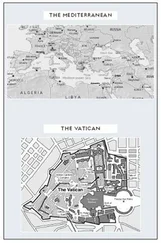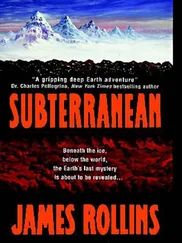Dr. Ogden grabbed her elbow, squeezing hard, stopping her. “Careful,” he said, drawing her eye, then pointing to the floor.
A few steps ahead lay an open well in the ice-rink floor. It was too perfectly oval to be natural, and the edges were scored coarsely.
“They dug one of them out from here.”
Amanda frowned. “One of what?” She spotted other pits in the ice now.
Henry tugged her to the side. “Over here.” He slipped a canteen of water from his belt. He motioned her down on a knee on the ice. They were now only a few yards from the shattered stone cliff. Hunched down, it was almost like they were on a frozen lake with the shore only a few steps away.
The biologist whisked the ice with his gloved hand. Then placed his flashlight facedown onto the frozen lake. Lit from on top, the section of ice under them glowed. But details were murky because of the frost on the ice’s surface. Still, Amanda could make out the dark shadow of something a few feet under the ice.
Henry sat back and opened his canteen. “Watch,” he mouthed to her.
Leaning over, he poured a wash of water over the surface, melting the frost rime and turning the ice to glass under them. The light shone clearly, limning what lay below in perfect detail.
Amanda gasped, leaning away.
The creature looked as if it were lunging up through the ice at her, caught for a moment in a camera’s flash. Its body was pale white and smooth-skinned, like the beluga whales that frequented the Arctic, and almost their same size, half a ton at least. But unlike the beluga, this creature bore short forelimbs that ended in raking claws and large webbed hind limbs, spread now, ready to sweep upward at her. Its body also seemed more supple than a whale’s, with a longer torso, curving like an otter. It looked built for speed.
But it was the elongated maw, stretched wide to strike, lined by daggered teeth, that chilled her to the bone. It gaped wide enough to swallow a whole pig. Its black eyes were half rolled to white, like a great white lunging after prey.
Amanda sat back and took a few puffs from her air warmer as her limbs tremored from the cold and shock. “What the hell is it?”
The biologist ignored her question. “There are more specimens!” He slid on his knees across the ice and revealed another of the creatures lurking just at the cliff face. This beast was curled in the ice as if in slumber, its body wrapped in a tight spiral, jaws tucked in the center, tail around the whole, not unlike a dog in slumber.
Henry quickly gained his feet. “That’s not all.”
Before she could ask a question, he crossed and entered a wide cleft in the rock face. Amanda followed, chasing after the light, still picturing the jaws of the monster, wide and hungry.
The cleft cut a few yards into the rock face and ended at a cave the size of a two-car garage.
Amanda straightened. Positioned against the back wall were six giant ice blocks. Inside each were frozen examples of the creatures, all curled in the fetal-like position. But it was the sight in the chamber’s center that had Amanda falling back toward the exit.
Like a frog in a biology lab, one of the creatures lay stretched across the ice floor, legs staked spread-eagle. Its torso was cut from throat to pelvis, skin splayed back and pinned to the ice. From the frozen state of the dissection, it was clearly an old project. But she caught only a glimpse of bone and organs and had to turn away.
She hurried back out onto the open frozen lake. Dr. Ogden followed. He seemed oblivious to her shock. He touched her arm to draw her eyes.
“A discovery of this magnitude will change the face of biology,” Henry said, bending close to her in his insistence. “Now you can see why I had to stop the geologists from ruining this preserved ecosystem. A find like this…preserved like this—”
Amanda cut him off. Her voice brittle. “What the hell are those things?”
Henry blinked at her and waved a hand. “Oh, of course. You’re an engineer.”
Though she was deaf, she could almost hear his condescension. She rankled a bit, but held her tongue.
He motioned back to the cleft and spoke more slowly. “I studied the specimen back there all day. I have a background in paleobiology. Fossilized remains of such a species have been discovered in Pakistan and in China, but never such a preserved specimen.”
“A specimen of what, Henry?” Her eyes were hard on the biologist.
“Of Ambulocetus natans . What is commonly called ‘the walking whale.’ It is the evolutionary link between land-dwelling mammals and the modern whale.”
She simply gaped at him as he continued.
“It is estimated to have existed some forty-nine million years ago, then died out some thirty-six million years ago. But the splayed out legs, the pelvis fused into the backbone, the nasal drift…all clearly mark this as distinctly Ambulocetus .”
Amanda shook her head. “You can’t be claiming that these specimens are so old. Forty million years?”
“No.” His eyes widened. “That’s just it! MacFerran says the ice at this level is only fifty thousand years old, dating back to the last ice age. And these specimens bear some unique features. My initial supposition is that some pod of Ambulocetus whales must have migrated to the Arctic regions, like modern whales do today. Once here, they developed Arctic adaptations. The white skin, the gigantism, the thicker layer of fat. Similar to the polar bear or beluga whales.”
Amanda remembered her own earlier comparison to the beluga. “And these creatures somehow survived up here until the last ice age? Without any evidence ever being discovered?”
“Is it really so surprising? Anything that lived and died on the polar ice cap would have simply sunk to the bottom of the Arctic Ocean, a region barely glimpsed at all. And on land, permafrost makes it nearly impossible to carry out digs above the Arctic Circle. So it is entirely possible for something to have existed for eons, then died out without leaving a trace. Even today we have barely any paleological record of this region.”
Amanda shook her head, but she could not dismiss what she had seen. And she couldn’t discount his argument. Only in the past decade, with the advent of modern technology and tools, was the Arctic region truly being explored. Her own team back at Omega was defining a new species every week. So far, the discoveries were just new, unclassified phytoplankton or algae, nothing on the level of these creatures.
Henry continued, “The Russians must have discovered these creatures when they dug out their base. Or maybe they built the base here because of them. Who knows?”
Amanda remembered Henry’s early claim: It’s the reason the station was built here . “What makes you think that?” She flashed back again to the discovery on Level Four. This new discovery, amazing as it was, seemed in no way connected to the other.
Henry eyed her. “Isn’t it obvious?”
Amanda scrunched her brow.
“ Ambulocetus fossils were only discovered in the past few years.” He pointed back to the cleft. “Back in World War Two, they knew nothing about them. So, of course, the Russians would come up with their own name for such a monster.”
Her eyes grew wide.
“They named their base after the creature,” Dr. Ogden explained needlessly. “A mascot of sorts, I imagine.”
Amanda stared down at the frozen lake, at the beast lunging up at her. She now knew what she was truly seeing. The monster of Nordic legend.
Grendel.
 Читать дальше
Читать дальше











